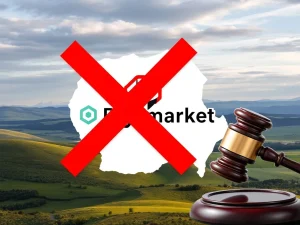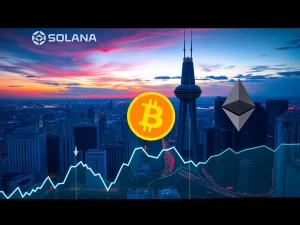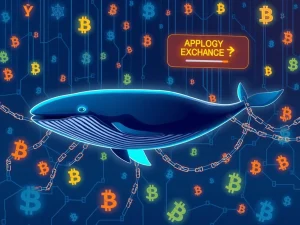Wormhole Token Surges: Revolutionary Tokenomics Overhaul Unleashes New Potential for W Token Holders

The cryptocurrency market often presents unexpected turns, and recently, the Wormhole token (W) delivered a compelling narrative. Its value surged following a significant overhaul of its Wormhole tokenomics. This strategic move aims to revitalize the token’s standing and bolster its ecosystem, drawing considerable attention from investors and blockchain enthusiasts alike.
Wormhole Token’s Journey: From Launch to Rebound
Wormhole, a prominent interoperability protocol, faced initial challenges with its native W token. The token debuted on April 3, 2024, at $1.66. However, it quickly experienced a significant decline, plummeting to $0.54 within approximately ten trading days. This drop occurred despite a generally bullish trend in the broader crypto market. Such volatility can test investor confidence.
Nevertheless, a recent announcement brought about a dramatic shift. On Wednesday, the Wormhole protocol unveiled updated tokenomics. This news immediately impacted the market. The Wormhole token price jumped over 6.3% on the day of the revision. This rebound demonstrates the market’s positive reception to the proposed changes. Investors are now closely watching Wormhole’s trajectory.
The protocol, established in late 2020, initially functioned as a bridge. It facilitated seamless transfers of tokens between Ethereum and Solana. Over time, its scope expanded significantly. Wormhole now supports numerous blockchain networks, cementing its role in the multi-chain future. The recent tokenomics update represents a crucial step in its ongoing evolution.
Understanding the Revolutionary Wormhole Tokenomics Overhaul
Wormhole Contributors revealed three key changes to the Wormhole tokenomics. These updates are designed to enhance the protocol’s stability, incentivize participation, and foster long-term growth. Each change plays a vital role in shaping the token’s future:
- W Reserve Launch: A new W reserve will be funded directly from protocol fees and revenue. This mechanism aims to create a sustainable pool of resources. It can support the ecosystem and potentially stabilize the token’s value over time.
- Enhanced Staking Yield: Stakers will now receive a 4% base yield. Furthermore, active participants in the ecosystem can earn even higher rewards. This initiative directly incentivizes users to hold and stake their W tokens. It also encourages deeper engagement with the protocol.
- Biweekly Unlocks: The previous bulk unlock schedule will transition to biweekly unlocks. This change aims to create a more predictable and gradual release of tokens. Consequently, it may reduce sudden supply shocks and promote market stability.
The Wormhole team articulated a clear vision for these changes. “The goal of Wormhole Contributors is to significantly expand the asset transfer and messaging volume that Wormhole facilitates over the next 1-2 years,” the protocol stated. Increased adoption is expected to lead to more locked tokens and greater revenue flowing back into the system. This creates a virtuous cycle of growth.
Bolstering Blockchain Governance with W Token Staking
The updated tokenomics directly impact the protocol’s blockchain governance structure. The W token serves as a fundamental governance mechanism. Users who stake their W tokens gain the ability to allocate voting power to delegates. These delegates then vote on critical decisions concerning the protocol’s operation and future development. This decentralized approach ensures community input.
Currently, a substantial amount of W is already staked. Approximately $45 million in W tokens are locked, demonstrating significant community commitment. Furthermore, 485 million W tokens have actively participated in governance votes. This highlights the engaged nature of the Wormhole community. The new staking incentives are likely to further strengthen this participation.
Notably, key figures within the Wormhole ecosystem hold considerable influence. Dan Reecer, co-founder of the Wormhole Foundation, currently commands the most significant voting power. He has $30.5 million in Wormhole tokens staked, representing 25.1% of the total voting power. Such concentrations of power are common in early-stage decentralized autonomous organizations (DAOs). However, the increased staking yield could encourage broader distribution of voting power over time. This would further decentralize governance.
The Competitive Landscape of Crypto Interoperability
Wormhole operates within a rapidly expanding and highly competitive sector: crypto interoperability. This functionality is becoming increasingly crucial in the multi-chain ecosystem. Interoperability protocols enable assets and data to move seamlessly across different blockchains. This capability is particularly vital for projects involving stablecoin issuance and Real World Asset (RWA) tokenization. These initiatives require the ability to deploy assets across multiple chains efficiently.
Wormhole faces competition from several established and emerging players. Key competitors include:
- Chainlink: Known for its decentralized oracle networks, Chainlink also offers cross-chain messaging services, connecting smart contracts across various blockchains.
- LayerZero: This omnichannel deployer focuses on building a secure and efficient communication layer between chains, enabling developers to create truly omnichain applications.
- Axelar: Axelar provides a universal overlay network. It connects all blockchains, allowing for secure cross-chain communication and asset transfers.
Each of these protocols employs distinct architectural approaches to achieve interoperability. Wormhole’s recent tokenomics enhancements aim to strengthen its position in this competitive landscape. By incentivizing staking and ensuring a robust reserve, Wormhole seeks to build a more resilient and attractive ecosystem for developers and users. This constant innovation is vital for survival and growth.
Community Reaction and Future Outlook for the W Token
The announcement of the tokenomics revision generated significant discussion on social media platforms, particularly X (formerly Twitter). While many users expressed optimism about the changes, some voiced disappointment. Specifically, they noted the absence of a second airdrop or a buyback-and-burn mechanism in the roadmap. These mechanisms are often employed to reduce a token’s circulating supply. Consequently, they can potentially boost its price.
However, Wormhole’s current strategy focuses on organic growth and utility. The protocol aims to increase adoption and facilitate greater asset transfer volume. This approach suggests a long-term vision. The new W reserve, funded by protocol revenue, serves as a different form of value accrual. It strengthens the ecosystem’s financial health rather than directly manipulating supply. This sustainable model could prove more beneficial in the long run.
The Wormhole team’s commitment to expanding asset transfer and messaging volume suggests a clear strategic direction. As the demand for crypto interoperability grows, protocols like Wormhole will become increasingly integral to the blockchain ecosystem. The recent tokenomics overhaul positions the W token and the protocol for sustained development. This makes it a crucial project to monitor in the evolving decentralized finance landscape.
Conclusion: Wormhole Token’s Path to Enhanced Utility and Stability
The recent surge in the Wormhole token price following its comprehensive tokenomics overhaul marks a pivotal moment for the protocol. By introducing a W reserve, offering enhanced staking yields, and transitioning to biweekly unlocks, Wormhole aims to build a more robust and sustainable ecosystem. These changes directly address market concerns and incentivize long-term participation.
The implications for blockchain governance are significant. Increased staking could lead to broader community engagement and a more decentralized decision-making process. Furthermore, Wormhole’s strengthened position within the competitive crypto interoperability sector is undeniable. As the demand for seamless cross-chain asset transfers continues to grow, Wormhole’s strategic enhancements could cement its role as a leading solution. The future of the Wormhole token appears promising, reflecting a renewed focus on utility, stability, and community-driven growth.








